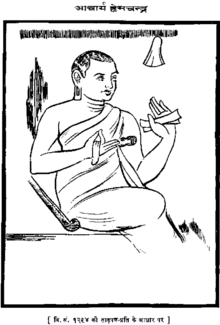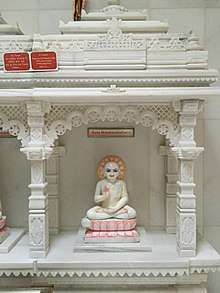Hemachandra
| Acharya Hemachandra | |
|---|---|
 Drawing of Hemchandra based on Vikram Samvat 1294 palm leaf | |
| Official name | Acharya Hemchandra Suri |
| Religion | Jainism |
| Sect | Śvētāmbara |
| Personal | |
| Born |
Changadev c. 1088 (see notes) Dhandhuka |
| Died |
c. 1173 (see notes) Anhilwad Patan |
| Parents | Chachinga, Pahini |
| Initiation |
Somchandra see notes Khambhat by Devchandrasuri |
| Part of a series on |
| Jainism |
|---|
 |
|
Jain prayers |
|
Ethics |
|
Major sects |
|
Festivals |
|
|
Acharya Hemachandra was a Jain scholar, poet, and polymath who wrote on grammar, philosophy, prosody, and contemporary history. Noted as a prodigy by his contemporaries, he gained the title kalikālasarvajña, "the all-knowing of the Kali Yuga".
Early life
Hemachandra was born in Dhandhuka, in present-day Gujarat, on Kartika Sud Purnima (the full moon day of Kartika month). His date of birth differs according to sources but 1088 is generally accepted.[note 1][1] His father, Chachiga-deva was a Modh Bania Vaishnava. His mother, Pahini, was a Jain.[2][3] Hemchandra's original given name was Changadeva. In his childhood, the Jain monk Devachandra Suri visited Dhandhuka and was impressed by the young Hemachandra's intellect. His mother and maternal uncle concurred with Devachandra, in opposition to his father, that Hemachandra be a disciple of his. Devachandra took Hemachandra to Khambhat, where Hemachandra was placed under the care of the local governor Udayana. Chachiga came to Udayana's place to take his son back, but was so overwhelmed by the kind treatment he received, that he decided to willingly leave his son with Devachandra.[4]
Some years later, Hemachandra was initiated a Jain monk on Magha Sud Chauth (4th day of the bright half of Magha month) and was given a new name, Somchandra. Udayana helped Devchandra Suri in the ceremony.[2][3] He was trained in religious discourse, philosophy, logic and grammar and became well versed in Jain and non–Jain scriptures. At the age of 21, he was ordained an acharya of the Śvētāmbara school of Jainism at Nagaur in present-day Rajasthan. At this time, he was named Hemachandra Suri.[2][3][5]
Hemachandra and Siddharaja
At the time, Gujarat was ruled by the Chaulukya dynasty from Anhilavada (Patan). It is not certain when Hemachandra visited Patan for the first time. As Jain monks are mendicants for eight months and stay at one place during Chaturmas, the four monsoon months, he started living at Patan during these periods and produced the majority of his works there.[2][3]
Probably around 1125, he was introduced to the Jayasimha Siddharaja (fl. 1092–1141) and soon rose to prominence in the Chaulukya royal court.[3] According to the Prabhavaka Charita of Chandraprabha, the earliest biography of Hemachandra, Jayasimha spotted Hemachandra while passing through the streets of his capital. The king was impressed with an impromptu verse uttered by the young monk.[6]
In 1135, when the Siddharaja conquered Malwa, he brought the works of Bhoja from Dhar along with other things. One day Siddhraja came across the manuscript of Sarasvati-Kanthabharana (also known as the Lakshana Prakash), a treatise on Sanskrit grammar. He was so impressed by it that he told the scholars in his court to produce a grammar that was as easy and lucid. Hemachandra requested Siddharaja to find the eight best grammatical treatises from Kashmir. He studied them and produced a new grammar work in the style of Pāṇini's Aṣṭādhyāyī.[2][3] He named his work Siddha-Hema-Śabdanuśāśana after himself and the king. Siddharaja was so pleased with the work that he ordered it to be placed on the back of an elephant and paraded through the streets of Anhilwad Patan.[7] Hemachandra also composed the Dvyashraya Kavya, an epic on the history of the Chaulukya dynasty, to illustrate his grammar.[3]
Hemachandra and Kumarapala

According to the Prabhachandra, there was an incident where Siddharaja wanted to kill his nephew Kumarapala because it was prophesied that the kingdom would meet its demise at Kumarapala's hands. Hemachandra hid Kumarapala under a pile of manuscripts to save him.[2] However, such motifs are common in Indian folk literature, so it is unlikely it was an actual historical event. Also, many sources differ on Siddharaja's motives.[2]
Hemachandra became the advisor to Kumarapala.[2][3] During Kumarapala's reign, Gujarat became a center of culture. Using the Jain approach of Anekantavada, Hemchandra is said to have displayed a broad-minded attitude, which pleased Kumarapala.[5] Kumarapala was a Shaiva and ordered the rebuilding of Somnath at Prabhas Patan. Some people who were jealous of Hemachandra's rising popularity with the Kumarapala complained that Hemachandra was a very arrogant person, that he did not respect the devas and that he refused to bow down to Shiva. When called upon to visit the temple on the inauguration with Kumarapala, Hemachandra readily bowed before the lingam but said:
Bhava Bijankaura-janana Ragadyam Kshayamupagata Yasya, Brahma va Vishnu va Haro Jino va Namastasmai.
I bow down to him who has destroyed the passions like attachment and malice which are the cause of the cycle of birth and death; whether he is Brahma, Vishnu, Shiva or Jina.[5][8]
Ultimately, the king became a devoted follower of Hemachandra and a champion of Jainism.[2][5]
Starting in 1121, Hemachandra was involved in the construction of the Jain temple at Taranga. His influence on Kumarapala resulted in Jainism becoming the official religion of Gujarat and animal slaughter was banned in the state. The tradition of animal sacrifice in the name of religion was completely uprooted in Gujarat. As a result, even almost 900 years after Hemchandra, Gujarat still continues to be a predominantly lacto-vegetarian state, despite having an extensive coastline.[2][3]
Death
He announced about his death six months in advance and fasted in his last days, a Jain practice called sallekhana. He died at Anhilwad Patan. The year of death differs according to sources but 1173 is generally accepted.[1]
Works
_LACMA_M.88.62.2.jpg)
_LACMA_M.88.62.1.jpg)
A prodigious writer, Hemachandra wrote grammars of Sanskrit and Prakrit, poetry, prosody, lexicons, texts on science and logic and many branches of Indian philosophy. It is said that Hemachandra composed 3.5 crore verses in total, many of which are now lost.
Jain philosophy
His systematic exposition of the Jain path in the Yogaśāstra and its auto-commentary is a very influential text in Jain thought. According to Olle Quarnström it is "the most comprehensive treatise on Svetambara Jainism known to us".[9]
Grammar
Siddha-Hema-Śabdanuśāśana
This Sanskrit grammar was written in the style of Pāṇini. It has seven chapters with each chapter having four sections, similar to that of the grammar of Bhoja. The Siddha-Hema-Śabdanuśāśana also includes six Prakrit languages: the "standard" Prakrit (virtually Maharashtri Prakrit), Shauraseni, Magahi, Paiśācī, the otherwise-unattested Cūlikāpaiśācī and Apabhraṃśa (virtually Gurjar Apabhraṃśa, prevalent in the area of Gujarat and Rajasthan at that time and the precursor of Gujarati language). He gave a detailed grammar of Apabhraṃśa and also illustrated it with the folk literature of the time for better understanding. It is the only known Apabhraṃśa grammar.[3]
Poetry
Dvyashraya Kavya
To illustrate the grammar, he produced the epic poetry Dvyashraya Kavya on the history of Chaulukya dynasty. It is an important source of history of region of the time.[3]
Trishashthi-Shalaka-Purusha
The epic poem Trīṣaṣṭiśalākāpuruṣacaritra or "Lives of Sixty-Three Great Men" is a hagiographical treatment of the twenty four tirthankaras and other important persons instrumental in defining the Jain philosophical position, collectively called the "śalākāpuruṣa", their asceticism and eventual liberation from the cycle of death and rebirth, as well as the legendary spread of the Jain influence. It still serves as the standard synthesis of source material for the early history of Jainism.[3] The appendix to this work, the Pariśiṣṭaparvan or Sthavirāvalīcarita,[10] contains his own commentary and is in itself a treatise of considerable depth[3] It has been translated into English as The Lives of the Jain Elders.[11]
Other
His Kavyanuprakasha follows the model of Kashmiri rhetorician Mammata's Kavya-prakasha. He quoted other scholars like Anandavardhana and Abhinavagupta in his works.[3]
Lexicography
Abhidhan-Chintamani (IAST abhidhāna-cintāmaṇi-kośa) is a lexicon while Anekarth Kosha is a lexicon of words bearing multiple meanings. Deshi-Shabda-Sangraho or Desi-nama-mala is the lexicon of local or non-Sanskrit origin. Niganthu Sesa is a botanical lexicon.[3]
Mathematics
Hemachandra, following the earlier Gopala, presented an earlier version of the Fibonacci sequence. It was presented around 1150, about fifty years before Fibonacci (1202). He was considering the number of cadences of length n, and showed that these could be formed by adding a short syllable to a cadence of length n − 1, or a long syllable to one of n − 2. This recursion relation F(n) = F(n − 1) + F(n − 2) is what defines the Fibonacci sequence.[12][13]
Other works
His other works are Chandanushasana (prosody), commentary in rhetoric work Alankara Chudamani, Abhidhana-chintamani,[2][14] Pramana-mimansa (logic), Vitaraga-Stotra (prayers).[3]
See also
Notes
- ↑ The dates of birth and death differs according to sources. He was initiated at age of 21.
- As per Dundas, (1089–??)[2]
- As per Datta and Jain World, (1088–1173)[3][5]
- As per Gujarat Gazetteers, Volume 18, (1087–1174)[15]
- As per Indian Merchants and Entrepreneurs, (1089–1173)[16]
References
- 1 2 Dinkar Joshi (1 January 2005). Glimpses of Indian Culture. Star Publications. pp. 79–80. ISBN 978-81-7650-190-3.
- 1 2 3 4 5 6 7 8 9 10 11 12 Paul Dundas (2002). The Jains. Psychology Press. pp. 134–135. ISBN 978-0-415-26606-2.
- 1 2 3 4 5 6 7 8 9 10 11 12 13 14 15 16 17 Amaresh Datta; various (1 January 2006). The Encyclopaedia Of Indian Literature (Volume One (A To Devo). 1. Sahitya Akademi. pp. 15–16. ISBN 978-81-260-1803-1.
- ↑ Asoke Kumar Majumdar 1956, p. 97.
- 1 2 3 4 5 "Hemacandra". Jain World. Archived from the original on 29 April 2008. Retrieved 6 May 2008.
- ↑ Asoke Kumar Majumdar 1956, p. 83.
- ↑ Jhaverchand Meghani (2003). A Noble Heritage: A Collection of Short Stories Based on the Folklore of Saurashtra. Bharatiya Vidya Bhavan. p. xviii.
- ↑ Encyclopaedia of Oriental Philosophy. Global Vision Pub House. p. 278. ISBN 978-81-8220-113-2.
- ↑ Olle Quarnström, The Yogasastra of Hemacandra : a twelfth century handbook of Svetambara Jainism, 2002, introduction
- ↑ Upinder Singh 2016, p. 26.
- ↑ Hemacandra; R. C. C. Fynes (1998). The Lives of the Jain Elders. Oxford University Press. ISBN 978-0-19-283227-6.
- ↑ Thomas Koshy (2001). Fibonacci and Lucas numbers with applications. John Wiley & Sons.
... before Fibonacci proposed the problem; they were given by Virahanka (between 600 and 800 AD), Gopala (prior to 1 135 AD), ...
- ↑ Philip Tetlow (2007). The Web's awake: an introduction to the field of Web science and the concept. John Wiley & Sons. ISBN 0-470-13794-0.
This sequence was first described by the Indian mathematicians Gopala and Hemachandra in 1150, who were investigating the possible ways of exactly packing items of length 1 and 2 into containers. In the West it was first studied by ...
- ↑ Olle Quarnström (2002), The Yogaśāstra of Hemacandra: A Twelfth Century Handbook of Śvetāmbara Jainism, Harvard University Press, ISBN 978-0674009349
- ↑ Gujarat (India) (1984). Gazetteers. Directorate of Government Print., Stationery and Publications. p. 183.
- ↑ Makrand Mehta (1 January 1991). Indian Merchants and Entrepreneurs in Historical Perspective: With Special Reference to Shroffs of Gujarat, 17th to 19th Centuries. Academic Foundation. p. 65. ISBN 978-81-7188-017-1.
Bibliography
- Asoke Kumar Majumdar (1956). Chaulukyas of Gujarat. Bharatiya Vidya Bhavan. OCLC 4413150.
- Singh, Upinder (2016), A History of Ancient and Early Medieval India: From the Stone Age to the 12th Century, Pearson Education, ISBN 978-93-325-6996-6
External links
- Bibliography of Hemachandra's works, Item 687, Karl Potter, University of Washington
- Acharya Hemchandra by Madhya Pradesh Hindi Granth Academy
- The Rhythm of Poetry
- The Golden Mean and the Physics of Aesthetics